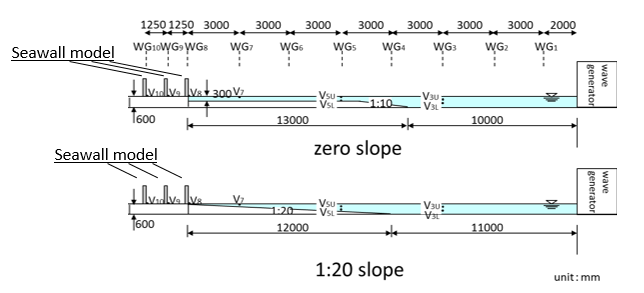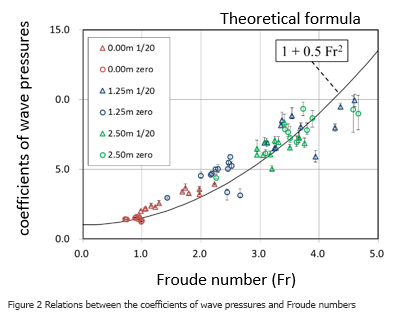A Method for Evaluating the Maximum Tsunami Wave Pressure on Seawalls

The seawall is one of the main coastal protection structures against tsunamis. Estimating tsunami wave pressures on a structure is quite important when designing seawalls. In this study, hydraulic flume tests and numerical simulations were conducted to investigate wave pressure characteristics. Correlations between wave pressures on a seawall and Froude numbers of flows were investigated. Finally, we proposed a method to evaluate the maximum wave pressure on seawalls.
Figure 1 shows a seawall model tested in a laboratory wave flume (Taisei Technology Center). The flume measured 47 m in length (1: 40 scale ratio) and 0.8 m in width. The wave generator at the end of the flume produced solitary waves, sine waves, and long-period waves. Two types of bed slopes near the shoreline were considered: a zero slope and a 1: 20 slope. Wave gages and pressure gages were set on the seawall model. We conducted two types of tests: (1) wave pressure tests with the seawall, and (2) wave run-up tests without the seawall. The wave run-up tests revealed flow characteristic parameters such as the Froude numbers. Wave run-up behavior was also investigated using a numerical wave flume (CADMAS-SURF). The wave pressure tests revealed that the behavior of wave pressures depended on the type of wave form and flume geometry, and the seawall location was not a significant parameter that influenced wave pressure magnitude. Moreover, a strong correlation between the wave pressures on the seawall and the Froude numbers of the flows was observed.
We considered a method for evaluating wave pressures on a seawall using the run-up test data. Figure 2 illustrates the relation between the coefficients of wave pressures and Froude numbers when the total kinetic and potential energy becomes the maximum. The black line shows a theoretical relation based on steady-state energy conservation. Although the actual flows were in a non-steady state, we concluded that wave pressures on the seawall could be predicted fairly accurately using an approach based on the assumption of a steady-state of run-up waves.
Relations between the Froude numbers and wave pressures acting on the seawall were investigated by flume tests and numerical simulations. Subsequently, we developed a method for evaluating the maximum wave pressure on the seawall. Even when the Froude numbers of the flows were very high, the approach was fairly successful at predicting the maximum wave pressure.

Takuya Toriyama
Regulatory Standard and Research Department, Secretariat of Nuclear Regulation Authority, Japan
takuya_toriyama@nsr.go.jp